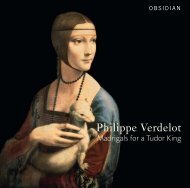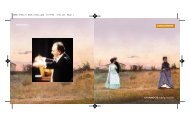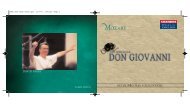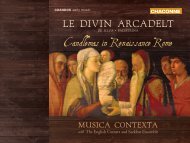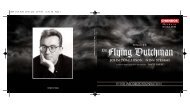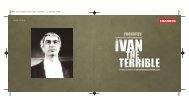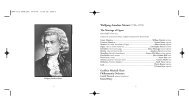You also want an ePaper? Increase the reach of your titles
YUMPU automatically turns print PDFs into web optimized ePapers that Google loves.
Introduction<br />
This collected edition afAksel Schiptz's recordings<br />
means the fulfilment of a great wish of mine.<br />
It touches me that the boards of Velux Fonden<br />
af 1981, Augustinus Fonden and Cul Nielsen og<br />
Anne Marie Cul-Nielsens Legat have sympathized<br />
with the wish to perpetuate Aksel Schiotz's art.<br />
Most of the recordings were issued on LPs,<br />
but they are now obsolete, nor have those transfers<br />
been as good as the originals. Listening now to the<br />
fresh and clean transfer made from ltne early<br />
pressings by Mr Andrew Walter, chief engineer of<br />
the EMI Abbey Road Studios, one is reminded how<br />
good the originals were. (They carry, most of the<br />
time, "take l" on them, which is to the credit of<br />
Aksel Schiotz as well as the engineers). It was<br />
HMV in London who discovered Aksel Schiotz<br />
and made him one of their artists, so it pleases me<br />
that the CDs ue produced in collaboration with the<br />
EMI Abbey Road Studios.<br />
The series is complete up till late 1946 when<br />
Aksel Schiotz barely suruived an operation which<br />
left half his face lame. His struggle to recover and<br />
to resume singing I, too, was involved in with<br />
natural strong feelings. But there were two separate<br />
periods, which must wisely be kept apart.<br />
So what is presented now are the complete<br />
recordings ofAksel Schiptz, the tenor Included re<br />
unklown documenttry recordings fiom those<br />
times, authorized for issue by me. I hope that the<br />
CDs will come into the hands of those who will<br />
love them bestl<br />
Gerd Schi4tz<br />
Gerd Schiotz:<br />
A Choral Conductor and a Mentor.<br />
Mogens Wcildike had lo:t no time in getting<br />
somewhere. When Aksel flrst met him in 1929, he<br />
was 32, M. A. in music, founder and conductor of<br />
the Palestrina Choir, and Music Supervisor for the<br />
Ministry of Education. He had become Thomas<br />
Laub's successor in Holmens Church and<br />
continued his restoration work for Lutheran church<br />
muslc.<br />
His first victory as an artist with the Palestrina<br />
Choir war to u in lst prize in a competition in<br />
Milan itself, the capital of madrigal singing. With<br />
his energy, audacity, imagination, and force of<br />
argument, he made the authorities of Copenhagen<br />
agree to make a "song school" as the basis for a<br />
Copenhagen Boys'Choir (will tum up in vols. 5<br />
and 6 of this Schigtz series. Ed.) Then he got<br />
himself the job as organist of Christiansborg Palace<br />
Church, and also had the choir installed in the<br />
same place.<br />
But the evidence that showed him as an arlirt,<br />
no less concentrated and clearheaded. were the<br />
weekly concerts in the Palace Chapel, for which he<br />
built up a wide-ranging repertoire with Palestrina,<br />
Bach, Handel as the pillars. It was not just the<br />
choristers who lemed old music, also a large<br />
audience was educated and lemed to appreciate it.<br />
Aksel was a tenor member of the Copenhagen<br />
Boys' and Male Choir. It was important fbr his<br />
later development that Woldike began to prepare<br />
him tbr oratorio singing by giving him solos at<br />
many concerts in the Palace Chapel.





